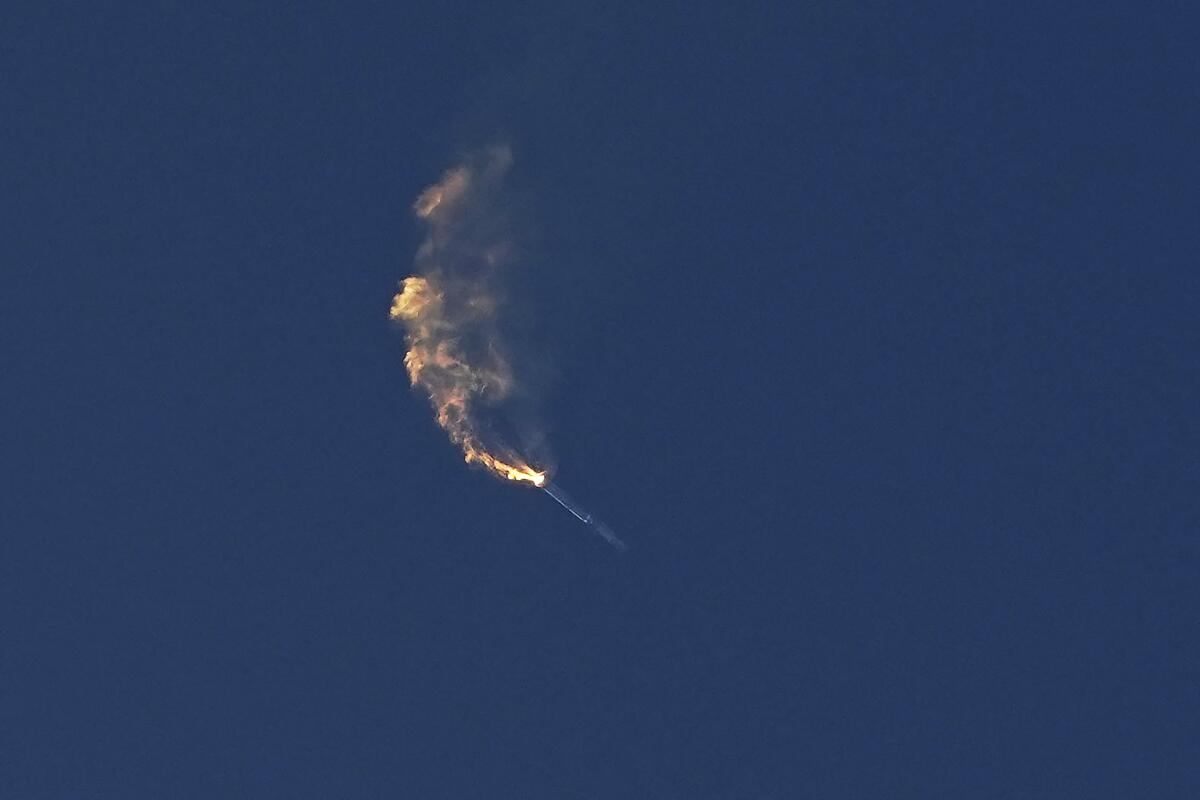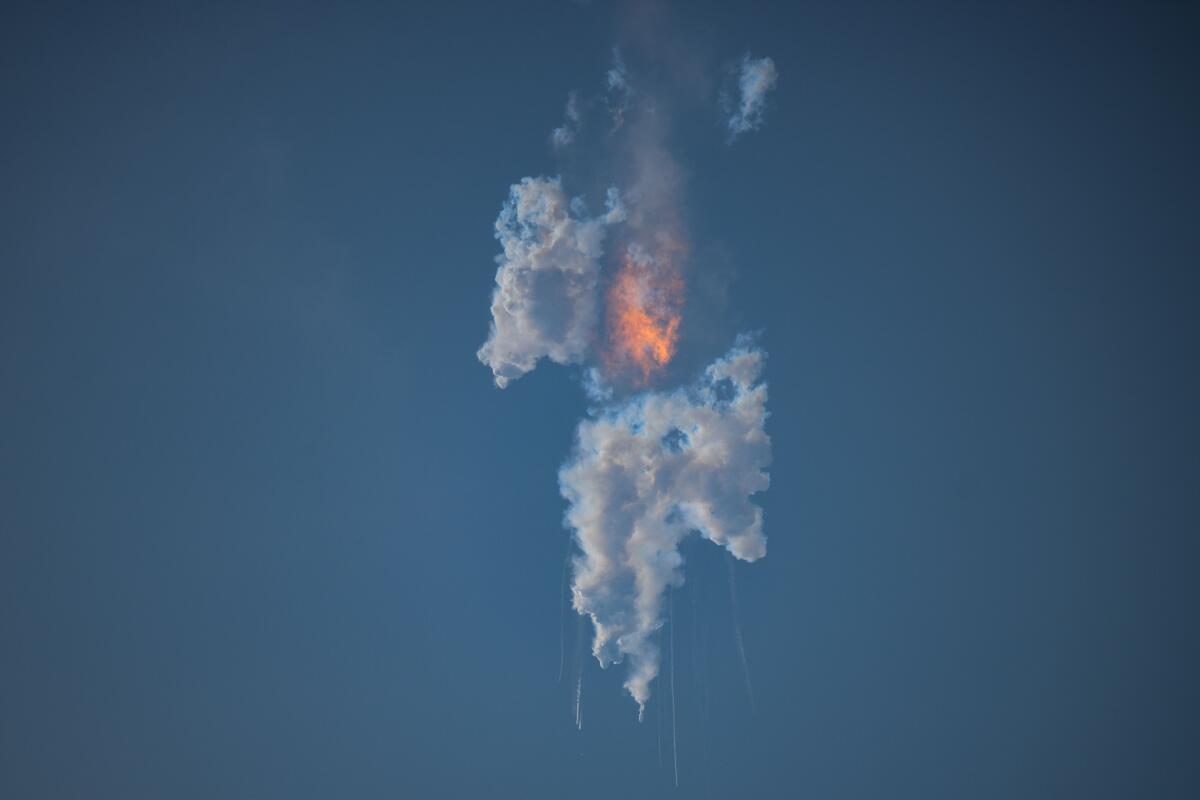Massive Starship rocket explodes after launch — SpaceX calls it a ‘win’

This was the first launch attempt of the company’s massive Starship moon rocket, which is crucial for the future of both SpaceX and U.S. plans for human space exploration.
- Share via
On its first test flight Thursday morning, SpaceX‘s massive, uncrewed Starship rocket — considered key to the future of U.S. human space exploration — roared off the launch pad and soared into the south Texas sky for a few minutes but ultimately exploded into a trail of smoke.
The explosive end to the test — the latest in the company’s years-long development program, but the first with the Starship spacecraft stacked atop the rocket’s Super Heavy first-stage booster — beat SpaceX’s publicly broadcast goals. The company had been careful to set expectations low for this flight. SpaceX Chief Executive Elon Musk told an audience at a Morgan Stanley conference last month that the rocket’s debut had a 50% chance of success.
“Success today is anything that we learn that helps improve the future builds of Starship,” Kate Tice, SpaceX quality systems engineering manager, said on the company’s launch webcast. “If we lift off and clear the pad, we’re going to have a win.”

The Starship rocket — currently the most powerful in the world — lifted off from the company’s launch site near Boca Chica, Texas, around 6:33 a.m. Pacific time. After passing through the moment of peak mechanical stress on the rocket and ascending about 24 miles above the Gulf of Mexico, the Starship spacecraft was set to separate from the Super Heavy first-stage booster.
But instead of separating, the still-conjoined rocket tumbled head over tail before it exploded. In typical SpaceX parlance, the company called it a “rapid unscheduled disassembly.”
SpaceX later confirmed that the explosion was due to Starship’s autonomous flight termination system, a safety measure embedded in the rocket’s software that destroys the launch vehicle if it senses that its course or performance is awry or unsafe. The company also said the rocket experienced multiple engines out during the flight and lost altitude.
The Federal Aviation Administration said in a statement that there were no reported injuries or damage to public property. The agency said that it will oversee the “mishap investigation” of the Starship test flight and that the rocket’s return to flight will happen only after the FAA deems that “any system, process or procedure related to the mishap does not affect public safety,” as is typical of this kind of investigation.
The Sierra Club’s Lone Star chapter, which has campaigned with other local organizations to amplify residents’ concerns about the effect of SpaceX’s launches on the nearby community, said it got reports of broken windows and shaking homes in nearby Port Isabel, Texas.
The rocket’s explosion in the air, away from the launch pad, probably limited the potential damage to crucial wintering sites for shorebirds, said Michael Parr, president of the nonprofit American Bird Conservancy. The organization has been concerned about SpaceX’s effect on nearby bird species and would like to see launches moved to more established launch sites such as Cape Canaveral in Florida, Parr said.
“My sense is that it’s good news today for sure, but it could have been so much worse,” he said.
Stacked together, the two-part rocket stands nearly 400 feet tall and can carry more than 220,000 pounds. It has about twice the thrust of the Apollo-era Saturn V rocket that propelled astronauts to the moon. The Super Heavy first-stage booster is powered by 33 engines.
Longtime Boca Chica resident and SpaceX launch documentarian Louis Balderas was filming the test flight from private property about 3.8 miles from the pad. The rocket’s liftoff, he said, felt like an earthquake.
“That thing rocked my gut,” Balderas said. “The whole place was shaking — I felt my stomach inside me shaking. It was insane.”
The launch spewed chunks of concrete, smaller pieces of equipment and general trash in the immediate vicinity, he said, though the debris didn’t reach the area where he and his crew were stationed.
One of his vehicles, however, wasn’t so lucky. Three of its windows were blown out by the force of the launch; the Chevrolet Suburban — equipped to livestream the event — was parked just 0.2 miles from the launch site. Another vehicle belonging to a YouTube streamer that was parked next to Balderas’ SUV was hit by chunks of concrete the size of bowling balls, he said.
“It was incredible to see the most incredible rocket in the world take off before our very eyes,” Balderas said. “It’s unfortunate it exploded the way it did, but that’s research and development for you.”
Musk congratulated the team on the launch via Twitter, saying they “learned a lot for next test launch in a few months.”
NASA Administrator Bill Nelson didn’t seem too concerned about the outcome of Thursday’s test flight, tweeting, “Every great achievement throughout history has demanded some level of calculated risk, because with great risk comes great reward. Looking forward to all that SpaceX learns, to the next flight test — and beyond.”
SpaceX is under contract with NASA to develop Starship as a lunar lander for the Artemis moon program.
Starship also is crucial to the future of Musk’s SpaceX.

Although SpaceX built its reputation and manifest on the smaller Falcon 9 rocket, the company needs to expand its business beyond launches. That’s where Starship comes in.
The Hawthorne company has already launched thousands of small satellites as part of its Starlink broadband internet constellation and offers service to the U.S. and countries around the globe. But those initial, smaller satellites are not advanced enough to fully implement SpaceX’s goal of being a major player in the broadband market.
SpaceX plans to launch more capable versions of the Starlink satellites that are larger and would require many more launches if flown on a Falcon 9 rocket. But with Starship’s carrying capacity, the company would be able to launch more satellites at a time, allowing SpaceX to build its broadband capacity faster and serve more customers.
Starlink is an important part of SpaceX’s plans for generating revenue. Musk told reporters in 2019 that revenue from providing internet service could total $30 billion a year, while launch revenue would top out at about $3 billion a year.
That kind of money is important for Musk’s ultimate goal — launching humans to Mars, which also requires Starship to ferry travelers to the red planet.
In the meantime, Starship already has missions closer to home on its docket. The rocket has been bought out by several billionaires for private spaceflights, including one intended to circle the moon that’s funded by Japanese fashion mogul Yusaku Maezawa.

Thursday’s launch came after a scrub Monday morning, when SpaceX delayed the launch due to a valve issue with the rocket.
Had the test mission gone off without a hitch, the Starship spacecraft would have separated from the Super Heavy booster and continued its ascent before coming back and hitting the Pacific Ocean in a “water landing” that would have intentionally exploded the spacecraft on impact, with most pieces expected to sink, according to an FAA launch evaluation. The Super Heavy booster was intended to return to the Gulf of Mexico, where it would have landed vertically in the water.
As it is, SpaceX will have to evaluate the rocket, as well as the launch pad, which appeared to sustain damage from Thursday’s test flight. Unlike its established pads at Cape Canaveral, SpaceX’s south Texas launch site does not have a cavernous flame trench, which is intended to divert energy away from the base of the rocket.
A functional launch site is key to keeping testing going, said Abhi Tripathi, who serves as director of mission operations at the UC Berkeley Space Sciences Lab and previously worked at SpaceX for 10 years.
“In the days and weeks and months ahead,” he said, “I think a great deal of energy will be focused on the design fixes to the pad, which may be even more relevant and important right now than the fixes to the vehicle.”
More to Read
Inside the business of entertainment
The Wide Shot brings you news, analysis and insights on everything from streaming wars to production — and what it all means for the future.
You may occasionally receive promotional content from the Los Angeles Times.












